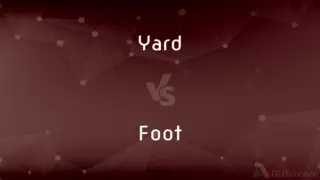Mandrill vs. Drill — What's the Difference?
Edited by Tayyaba Rehman — By Urooj Arif — Updated on March 15, 2024
Mandrills are vibrant, large primates known for their colorful faces and rumps, while drills are more subdued in color, focusing on social structures.

Difference Between Mandrill and Drill
Table of Contents
ADVERTISEMENT
Key Differences
Mandrills are among the largest and most colorful of the monkey family, easily identifiable by their striking blue and red facial features and brightly colored rear ends, which serve as social signals among the species. Drills, on the other hand, have more subdued coloration, primarily black and gray, with less pronounced facial coloration, emphasizing their less visible social and hierarchical structures within groups.
While mandrills have a more diverse habitat range within the rainforests of western-central Africa, living in both forested and savanna environments, drills are more limited in their distribution, primarily residing in the dense forests of West Africa. This difference in habitat preferences highlights their adaptability and ecological niches.
Mandrills are known for their large, multi-male and multi-female groups, which can include hundreds of individuals, showcasing a complex social structure that emphasizes the importance of visual signals for communication. Drills, whereas, often form smaller groups, usually with a single dominant male and multiple females, indicating a different approach to social organization and group dynamics.
Dietary habits of mandrills are omnivorous, with a diet consisting of fruits, seeds, insects, and occasionally small animals, reflecting their adaptability to different food sources available in their habitats. Drills, on the other hand, have a similar diet but are known to have a stronger preference for fruit, which makes up a larger portion of their diet, highlighting slight variations in foraging behavior and ecological impacts.
Mandrills play a significant role in their ecosystems as seed dispersers, contributing to the health and regeneration of their habitats. Drills also contribute to seed dispersal, but their more restricted range and smaller population sizes mean their impact is more localized, underlining differences in ecological roles and conservation concerns.
ADVERTISEMENT
Comparison Chart
Appearance
Colorful face and rump, larger size
Subdued colors, less pronounced facial features
Habitat
Western-central Africa, diverse environments
West Africa, dense forests
Social Structure
Large groups, complex hierarchies
Smaller groups, single dominant male
Diet
Omnivorous, varied
Omnivorous, strong fruit preference
Conservation Role
Seed dispersers, wide impact
Seed dispersers, localized impact
Compare with Definitions
Mandrill
Primarily found in the rainforests and savannas of western-central Africa.
In the heart of the Congo, mandrills thrive in both dense forests and open savannas.
Drill
Drills have less vibrant colors compared to mandrills, primarily featuring grays and blacks.
The drill blended into the shadowy underbrush with its dark coat.
Mandrill
Mandrills are known for their vibrant colors, especially on their faces and rumps.
The mandrill's face lit up in a spectrum of blues and reds as it approached.
Drill
They form smaller groups led by a dominant male.
A drill family foraged quietly, led by a single large male.
Mandrill
As seed dispersers, they play a crucial role in their ecosystems.
Feasting on fruit, the mandrill inadvertently helped plant tomorrow's trees.
Drill
They contribute to seed dispersal within their more limited range.
The drill consumed fruit, dispersing seeds throughout its forest home.
Mandrill
They live in large social groups, navigating complex hierarchies.
A troop of mandrills moved through the forest, their numbers and noise intimidating.
Drill
Drills prefer a diet heavier in fruit than mandrills.
The drill eagerly reached for the ripest mangoes on the tree.
Mandrill
Their diet includes fruits, insects, and small animals.
The mandrill foraged for berries, occasionally catching insects.
Drill
Drills are found in the dense forests of West Africa.
Drills are elusive, hidden within the dense greenery of Cameroon's forests.
Mandrill
The mandrill (Mandrillus sphinx) is a primate of the Old World monkey (Cercopithecidae) family. It is one of two species assigned to the genus Mandrillus, along with the drill.
Drill
A drill or drilling machine is a tool primarily used for making round holes or driving fasteners. It is fitted with a bit, either a drill or driver, depending on application, secured by a chuck.
Mandrill
A large terrestrial monkey (Mandrillus sphinx) of dense forests of west-central Africa, having an olive-brown body with a brightly colored rump and face that are especially pronounced in the male.
Drill
A tool or machine with a rotating cutting tip or reciprocating hammer or chisel, used for making holes.
Mandrill
A primate, Mandrillus sphinx, with colorful face and rump.
Drill
Instruction or training in military exercises
Parade-ground drill
Mandrill
Baboon of west Africa with red and blue muzzle and hindquarters
Drill
A predatory mollusc that bores into the shells of other molluscs in order to feed on the soft tissue.
Drill
A machine which makes small furrows, sows seed in them, and then covers the seed with earth.
Drill
A dark brown baboon with a short tail and a naked blue or purple rump, found in the rainforests of West Africa.
Drill
A coarse twilled cotton or linen fabric
Top quality cotton drill with reinforced seams
Sturdy clothes in drill, denim and linen
Drill
Produce (a hole) in something by or as if by boring with a drill
Drill holes through the tiles for the masonry pins
Drill
Subject (someone) to military training exercises
A sergeant was drilling new recruits
Drill
Sow (seed) with a drill
Crops drilled in autumn
Drill
An implement with cutting edges or a pointed end for boring holes in hard materials, usually by a rotating abrasion or repeated blows; a bit.
Drill
The hand-operated or hand-powered holder for this implement.
Drill
A loud, harsh noise made by or as if by a powered tool of this kind.
Drill
Disciplined, repetitious exercise as a means of teaching and perfecting a skill or procedure.
Drill
A task or exercise for teaching a skill or procedure by repetition
Conducted an air-raid drill.
A drill for learning the multiplication tables.
Drill
The training of soldiers in marching and the manual of arms.
Drill
Any of various marine gastropod mollusks, chiefly of the genus Urosalpinx, that bore holes into the shells of bivalve mollusks. U. cinera is destructive to oysters.
Drill
A shallow trench or furrow in which seeds are planted.
Drill
A row of planted seeds.
Drill
A machine or implement for planting seeds in holes or furrows.
Drill
Durable cotton or linen twill of varying weights, generally used for work clothes.
Drill
A large monkey (Mandrillus leucophaeus) of west-central African forests, having an olive brown body and a brightly colored face and resembling the mandrill.
Drill
To make a hole in (a hard material) with a drill
A bit for drilling masonry.
Drill
To make (a hole) with or as if with a drill
Drills holes in trees with its chisellike bill.
Drill
To strike or hit sharply
The batter drilled a single through the infield.
Drill
To instruct thoroughly by repetition in a skill or procedure
Drill pupils in grammar.
Drill
To infuse knowledge of or skill in by repetitious instruction
Drilled the correct spellings into the students' heads.
Drill
To train (soldiers) in marching and the manual of arms.
Drill
To make a hole with or as if with a drill.
Drill
To perform a training exercise.
Drill
To sow (seeds) in rows.
Drill
To plant (a field) in drills.
Drill
(transitive) To create (a hole) by removing material with a drill tool.
Drill a small hole to start the screw in the right direction.
Drill
(intransitive) To practice, especially in (or as in) a military context.
They drilled daily to learn the routine exactly.
Drill
(ergative) To cause to drill practice; to train in military arts.
The sergeant was up by 6:00 every morning, drilling his troops.
Drill
(transitive) To repeat an idea frequently in order to encourage someone to remember it.
The instructor drilled into us the importance of reading the instructions.
Drill
To investigate or examine something in more detail or at a different level
Drill deeper and you may find the underlying assumptions faulty.
Drill
(transitive) To hit or kick with a lot of power.
Drill
(baseball) To hit someone with a pitch, especially in an intentional context.
Drill
(slang) To shoot; to kill.
Drill
(transitive) To sow (seeds) by dribbling them along a furrow or in a row.
Drill
(transitive) To cause to flow in drills or rills or by trickling; to drain by trickling.
Waters drilled through a sandy stratum
Drill
To protract, lengthen out; fritter away, spend (time) aimlessly.
Quit purposely drilling out the time hoping that someone else will do your chores.
Drill
To entice or allure; to decoy; with on.
Drill
To cause to slip or waste away by degrees.
Drill
A tool used to remove material so as to create a hole, typically by plunging a rotating cutting bit into a stationary workpiece.
Wear safety glasses when operating an electric drill.
Drill
The portion of a drilling tool that drives the bit.
Use a drill with a wire brush to remove any rust or buildup.
Drill
An activity done as an exercise or practice (especially a military exercise), particularly in preparation for some possible future event or occurrence.
Regular fire drills can ensure that everyone knows how to exit safely in an emergency.
Drill
A short and highly repeatable sports training exercise designed to hone a particular skill that may be useful in competition.
Drill
Any of several molluscs, of the genus Urosalpinx, especially the oyster drill (Urosalpinx cinerea), that drill holes in the shells of other animals.
Drill
A style of trap music with gritty, violent lyrics, originating on the South Side of Chicago.
Drill
An agricultural implement for making holes for sowing seed, and sometimes so formed as to contain seeds and drop them into the hole made.
Drill
A light furrow or channel made to put seed into, when sowing.
Drill
A row of seed sown in a furrow.
Drill
(obsolete) A small trickling stream; a rill.
Drill
An Old World monkey of West Africa, Mandrillus leucophaeus, similar in appearance to the mandrill, but lacking the colorful face.
Drill
A strong, durable cotton fabric with a strong bias (diagonal) in the weave.
Drill
To pierce or bore with a drill, or a with a drill; to perforate; as, to drill a hole into a rock; to drill a piece of metal.
Drill
To train in the military art; to exercise diligently, as soldiers, in military evolutions and exercises; hence, to instruct thoroughly in the rudiments of any art or branch of knowledge; to discipline.
He [Frederic the Great] drilled his people, as he drilled his grenadiers.
Drill
To practice an exercise or exercises; to train one's self.
Drill
To cause to flow in drills or rills or by trickling; to drain by trickling; as, waters drilled through a sandy stratum.
Drill
To sow, as seeds, by dribbling them along a furrow or in a row, like a trickling rill of water.
Drill
To entice; to allure from step; to decoy; - with on.
See drilled him on to five-fifty.
Drill
To cause to slip or waste away by degrees.
This accident hath drilled away the whole summer.
Drill
To trickle.
Drill
To sow in drills.
Drill
An instrument with an edged or pointed end used for making holes in hard substances; strictly, a tool that cuts with its end, by revolving, as in drilling metals, or by a succession of blows, as in drilling stone; also, a drill press.
Drill
The act or exercise of training soldiers in the military art, as in the manual of arms, in the execution of evolutions, and the like; hence, diligent and strict instruction and exercise in the rudiments and methods of any business; a kind or method of military exercises; as, infantry drill; battalion drill; artillery drill.
Drill
Any exercise, physical or mental, enforced with regularity and by constant repetition; as, a severe drill in Latin grammar.
Drill
A marine gastropod, of several species, which kills oysters and other bivalves by drilling holes through the shell. The most destructive kind is Urosalpinx cinerea.
Drill
A small trickling stream; a rill.
Springs through the pleasant meadows pour their drills.
Drill
An implement for making holes for sowing seed, and sometimes so formed as to contain seeds and drop them into the hole made.
Drill
A large African baboon (Cynocephalus leucophæus).
Drill
Same as Drilling.
Drill
A tool with a sharp point and cutting edges for making holes in hard materials (usually rotating rapidly or by repeated blows)
Drill
Similar to the mandrill but smaller and less brightly colored
Drill
Systematic training by multiple repetitions;
Practice makes perfect
Drill
(military) the training of soldiers to march (as in ceremonial parades) or to perform the manual of arms
Drill
Make a hole with a pointed power or hand tool;
Don't drill here, there's a gas pipe
Drill a hole into the wall
Drill for oil
Drill
Train in the military, e.g., in the use of weapons
Drill
Learn by repetition;
We drilled French verbs every day
Pianists practice scales
Drill
Teach by repetition
Drill
Undergo military training or do military exercises
Common Curiosities
What distinguishes a mandrill's appearance from a drill's?
Mandrills have bright blue and red facial colors and colorful rumps, while drills have more subdued gray and black colors.
Can both mandrills and drills be considered seed dispersers?
Yes, both play roles as seed dispersers, but mandrills have a wider impact due to their larger distribution and population sizes.
Are mandrills or drills more threatened in the wild?
Both face conservation issues, but drills are often considered more at risk due to their limited range and habitat destruction.
Why are mandrills considered more visible in their habitats compared to drills?
Mandrills' bright colors and larger groups make them more noticeable, while drills' subdued colors and smaller groups make them less visible.
Where can you find mandrills and drills in the wild?
Mandrills are found in western-central Africa, in both forests and savannas, while drills are limited to the dense forests of West Africa.
What are the dietary preferences of mandrills compared to drills?
Both are omnivorous, but mandrills have a more varied diet, whereas drills show a stronger preference for fruit.
What role do visual signals play in mandrill and drill societies?
Visual signals are crucial for mandrills in social communication, while drills rely less on visual signals due to their smaller, less complex groups.
How do the habitats of mandrills and drills affect their behavior and diet?
Mandrills' diverse habitats allow a varied diet and social structures, while drills' dense forest habitats influence their fruit-heavy diet and smaller groups.
How do mandrills and drills differ in their social structures?
Mandrills live in large, complex social groups, whereas drills form smaller groups with a single dominant male.
How do researchers study mandrills and drills in the wild?
Through field studies, tracking, and observation, researchers gather data on their behavior, diet, and social structures to aid in conservation efforts.
How do mandrills and drills communicate within their groups?
Both use vocalizations and body language, but mandrills also use their vibrant colors for communication.
What is the size comparison between mandrills and drills?
Mandrills are generally larger and more robust than drills.
How do mandrills and drills contribute to their ecosystems?
As seed dispersers, they help in the regeneration of forests, with mandrills having a broader ecological impact.
What challenges do mandrills and drills face in their natural habitats?
Habitat loss, hunting, and disease are major threats to both species, affecting their populations and conservation status.
What conservation efforts are in place for mandrills and drills?
Conservation efforts include habitat protection, anti-poaching measures, and breeding programs, with specifics varying by region and species.
Share Your Discovery

Previous Comparison
Airship vs. Airplane
Next Comparison
Yard vs. FootAuthor Spotlight
Written by
Urooj ArifUrooj is a skilled content writer at Ask Difference, known for her exceptional ability to simplify complex topics into engaging and informative content. With a passion for research and a flair for clear, concise writing, she consistently delivers articles that resonate with our diverse audience.
Edited by
Tayyaba RehmanTayyaba Rehman is a distinguished writer, currently serving as a primary contributor to askdifference.com. As a researcher in semantics and etymology, Tayyaba's passion for the complexity of languages and their distinctions has found a perfect home on the platform. Tayyaba delves into the intricacies of language, distinguishing between commonly confused words and phrases, thereby providing clarity for readers worldwide.
















































